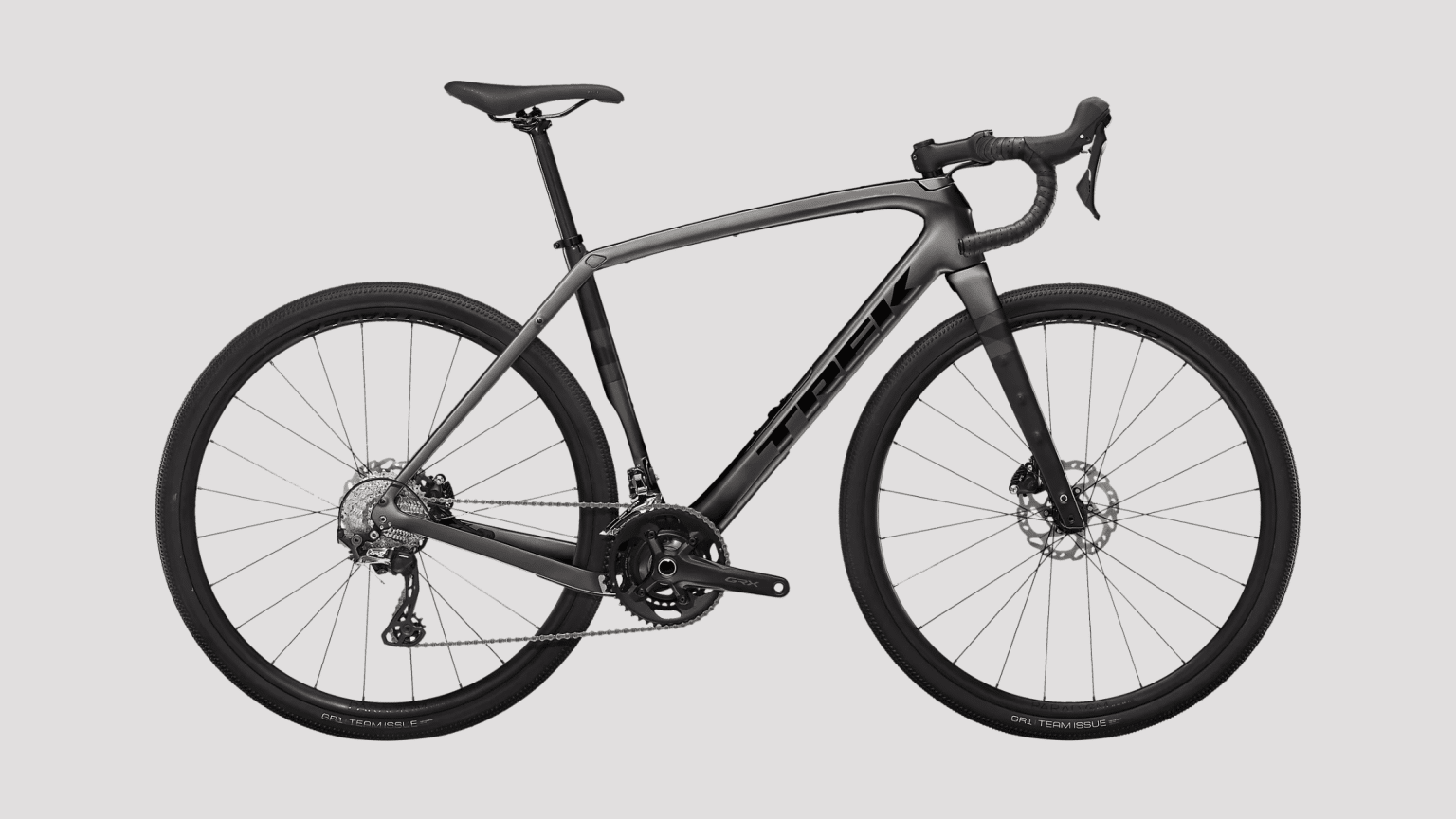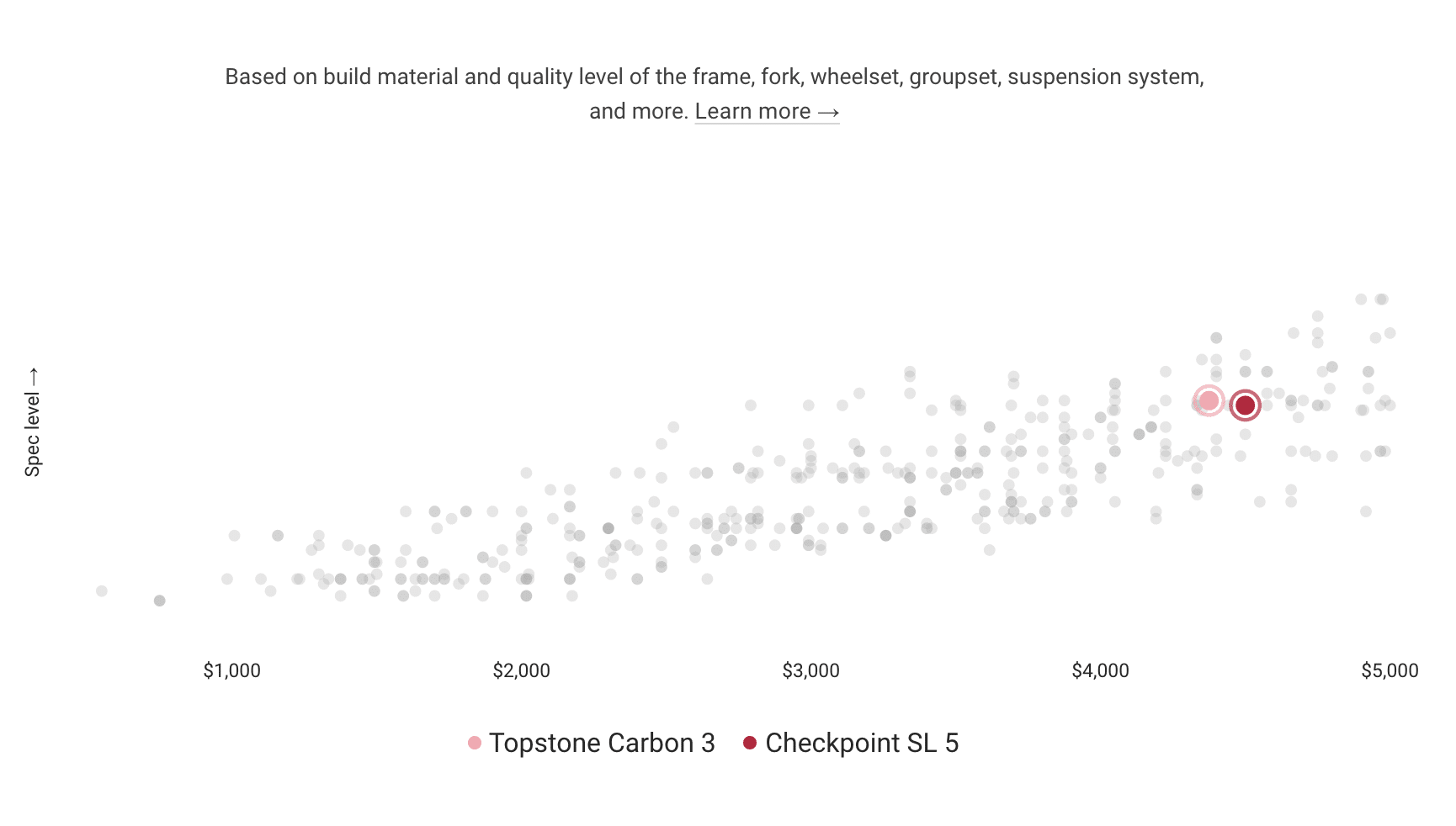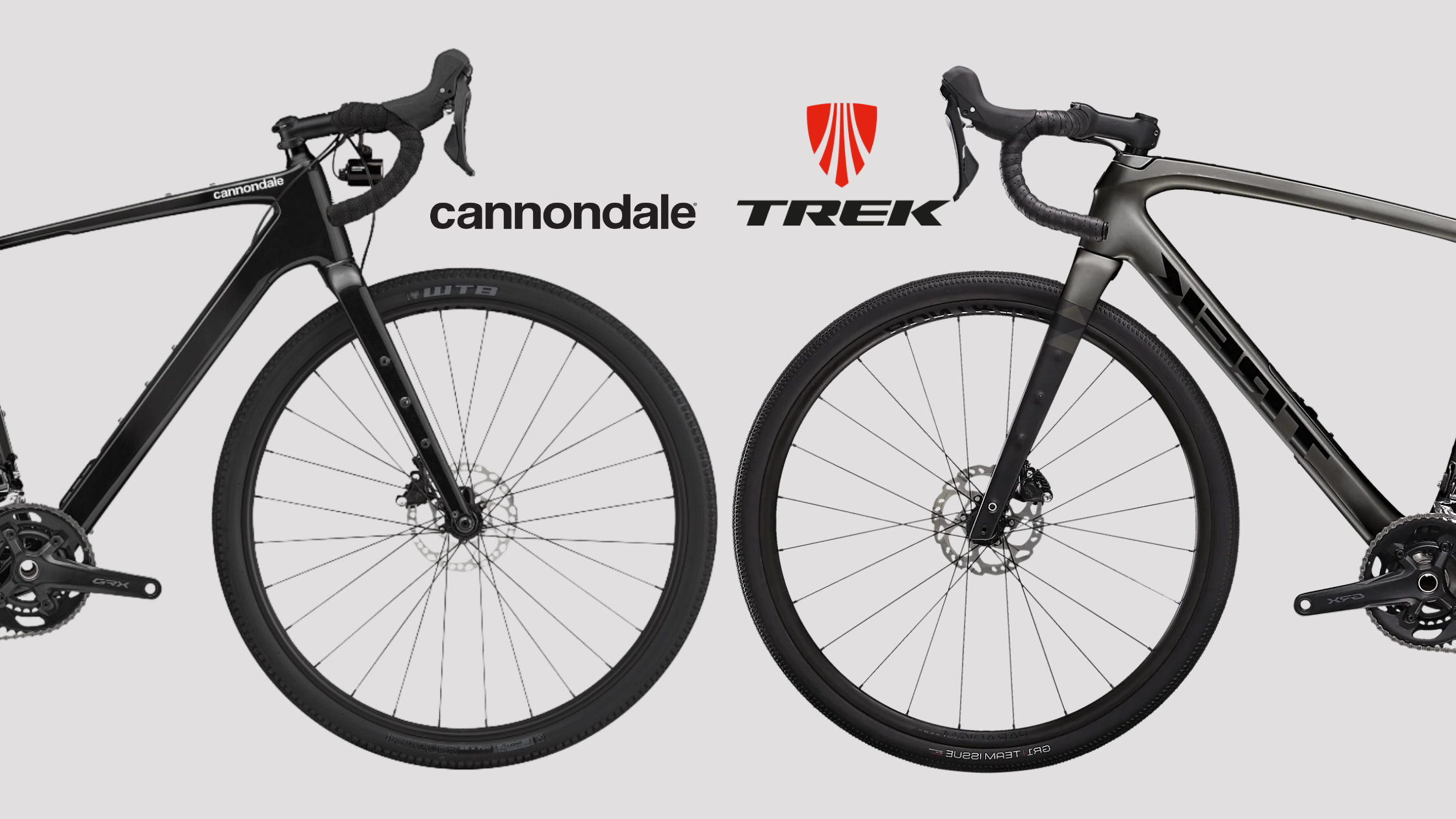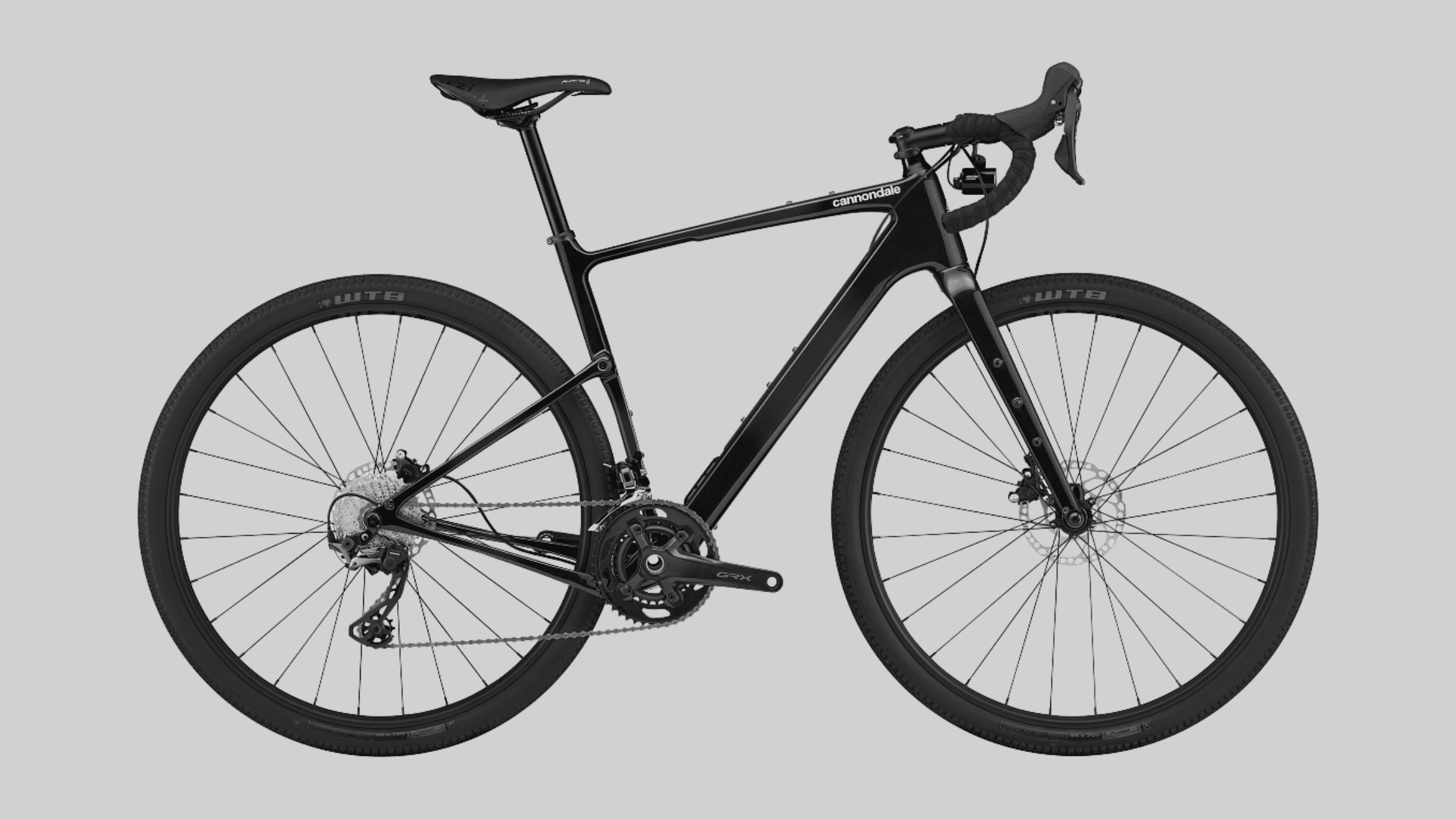The big brand gravel bike battle! Trek vs Cannondale! The big kids on the block who have been around forever. Which gravel bike is best? We are going to compare these two iconic gravel bikes side by side and see what the difference is between each.
Introducing the Trek Checkpoint

The Trek Checkpoint seems to be one of the most popular gravel bikes on the market. So that means they are a great carbon gravel bike option, right? The main feature of the Checkpoint is the lightweight OCLV Carbon frame with IsoSpeed, a decoupler at the top tube/seat tube junction that provides additional compliance over rough terrain so you can stay stronger for longer. A carbon gravel bike made for epic all-road adventures.
Introducing the Cannondale Topstone
Just looking at this bike it is clearly the better option if you want something that you can take on adventures. Yes, it is the more expensive bike out of the two. You do get the choice to buy much more affordable models. This model though boasts some interesting features, that are definitely worth considering.
The main feature worth mentioning is the bike’s Kingpin suspension system. Delivering a smooth ride without the added weight and complexity of a shock and links. Whether you need more comfort to go long, or more traction to push beyond. This intuitive suspension design has you covered, offering that little extra comfort for those grueling gravel-grinding adventures.
You also get the SmartSense’s system of intelligent lights (and optional rear-facing radar) which increases your visibility out on the open road and makes it easy to ride smart.
Dropper compatible, and you get all the mounting options you could need for your next bikepacking trip. This bike is a no-brainer if you want your next all-rounder adventure gravel bike.
Price – Topstone Vs Checkpoint
When it comes to price the Topstone has a plethora of options ranging from $1,375 to $7,850. While the Checkpoint ranges from $3,499 to $12,249. But what really is the difference and which one is best for you and your riding goals?
There are so many different models to choose from for each bike. For this article, we have taken their mid-range (best bang for buck option as a main comparison. Instead of comparing all models together.)

But when taking a look at these two, mid to high-end range models. There is a slight difference when it comes to price. The Topestone comes in at around $75 more affordable considering both bikes are similar in spec level. With the Cannondale Topstone Carbon 3 L priced at $3,325 and the Trek Checkpoint SL 5 at $3,399.99.
One can even argue that the topstone has slightly better quality componentry. Making it the bike with the best bank for buck out of the two.
Weight – Topstone Vs Checkpoint
The Cannondale Topstone weighs around 23.3 pounds / 10.57 kg, while the Trek Checkpoint weighs around 21.4 lbs / 9.71 kg. All different build options and models weigh differently. But from the numbers above we can see the Checkpoint has a slightly lighter weight construction.
So far these bikes seem very similar but I am sure once we find out more about geometry and gearing we will get a better idea of which bike is best for your intended type of riding.
Tire Clearance – Topstone Vs Checkpoint
When it comes to tire clearance the Checkpoint fits 45mm x 700c or 2.1″ (which is approx 53 mm) x 650b wheels. While the Topstone fits the same, up to 700c x 45mm or 27.5 x 2.1″, with 6mm of mud-shedding clearance. Both bikes again show similarities again and again.
The Cannondale comes stock with either WTB Riddler 700 x 45c or Vittoria Terreno Dry 700 x 38c tires. While the Trek comes with Bontrager GR1 Team Issue 700c x 40 mm tires.
Gearing – Topstone Vs Checkpoint
Both are similar when it comes to gearing (both with 2×11 GRX 800 drivetrains) and hydraulic disc brakes.
They are again identical with the exact same crank and cassette with the same teeth sizes.

We can calculate that the Topstone has a climbing gear of 24.67″ while the Checkpoint has a 24.32″, this slightly lower number is thanks to the 40 mm tires which are 5 mm thinner than the 45mm WTb Riddlers we used for calculating the Cannondale.
If both bikes had identical tires then the gear ratio and inches would be exactly the same. which again makes it hard to pick these bikes apart.
It’s important to note that this climbing gear isn’t the most ideal for solely bikepacking. You want something more like an MTB at 18″ to 20″.
When it comes to the largest gear is often attributed to riding fast on the flats or riding downhill. The Checkpoint offers a 115.53″ vs the Topstone’s 117.17″, on paper these bikes should have the exact same largest gear but tires slightly skew the numbers.
Geometry – Topstone Vs Checkpoint
Geometry can play a big part in the difference between how a bike rides and feels. It is definitely something to consider when buying a bike. Okay, the moment I have been waiting for! So far these bikes have been rather similar in many ways. Here is where if there are any differences we can figure out which bike is better suited for you. All the measurements below are in mm and are for both medium-sized bikes.
Want to learn more about understanding bike geometry? Read this article which goes through all the jargon and what it means for a comfortable ride!
The main geometry specs that can paint the picture of the type of bike we are looking at are; stack/reach ratio, trail, chainstay, and wheelbase.
Firstly the stack/reach ratio for the Checkpoint 1.42 vs the Topstione 1.50, suggests that the Topstone is a more upright bike and the Checkpoint is slightly more aggressive.
Meaning that the Topstone would be in theory a more comfortable bike to ride on bikepacking trips and for longer amounts of time in the saddle. While the Checkpoint would be better for performance-based riding where comfort isn’t as important and riding fast is the main priority. (Although this number is much more aggressive on some of the fastest gravel bikes.)
Chainstay is 15 mm longer on the Checkpoint. With measurements of 435 mm puts the Checkpoints chainstay right in that mid-range for a gravel bike, Which is where most all-rounder gravel bikes sit. While the Topstone measures 420 mm this means it’s rather short making it feel jumpy and quick in the rear. Compared to a more balanced feel of the Checkpoint.
Specifically, if you want to run panniers the Checkpoint is your best bet this longer chainstay offers a more comfortable clearance from your feet and legs when pedaling.
But that longer chainstay and I am assuming wheelbase also makes the Checkpoint a more stable and planted bike especially when bikepacking or bicycle touring. The more stable the bike under a load the better.
And this is evident with the Checkpoint having a 12 mm longer wheelbase.
Now we’ll look at the trail. this tells the story of how each bike with corner and what the handling is like up front.
The Topstone has an 8 mm shorter trail length at 62 mm which is in the mid-range for gravel bikes making it feel rather predictable up front. The Topstones geometry is interesting it was built with a faster rear end but a good balance and not too quick front.
Then we have the Checkpoints 70 mm trail which is getting into the high end for gravel bikes. Making it feel rather stable upfront but not quite sluggish. So both bikes are in a goldilocks zone of well-balanced trail measurements.
But again overall from these numbers, we can assume that the Trek Checkpoint is the more stable bike when it comes to riding with all your gear and if you are looking at these bikes to mostly go on adventures. And because here at Cycle Travel overload that’s all we are about. The Checkpoint I would recommend as your go-to.
And because they are both perfect all-rounder gravel bikes. It seems the Checkpoint has that slight edge when it comes to practicality and cycling adventures.
| Bike | Checkpoint | Topstone |
| Stack | 571 | 574 |
| Reach | 403 | 383 |
| Stack/Reach Ratio | 1.42 | 1.50 |
| Top Tube Length | 570 | 532 |
| Seat Tube Length | 540 | 505 |
| Seat Tube Angle | 73.2 | 73.1 |
| Head Tube Length | 125 | 150 |
| Head Tube Angle | 71.8 | 71.2 |
| BB Drop | 76 | 67 |
| Front Center | 617 | 617 |
| Chainstay Length | 435 | 420 |
| Wheelbase | 1041 | 1029 |
| Rake | 45 | 55 |
| Trail | 70 | 62 |
| Standover Height | 789 | 785 |
But having that said. We have failed to take into consideration the Cannondale Topstones suspension technology. Just because it doesn’t have traditionally ideal geometry numbers for the most stable adventure bike. It doesn’t mean you still can’t have any fun.
And I might argue that looking at the details of the Cannondale you might have more fun on it compared to the Trek. Thanks to the shorter chainstay and Kingpin suspension.
I can see this bike being perfect for those fast and quick adventures. As the suspension technology could potentially make up for the more aggressive angle and geometry lengths compared to the more comfortable Checkpoint. This suspension could help in aiding in that extra comfort over the long haul.
So if being the fastest adventurer is in your plans. Maybe riding a long-distance bikepacking event. Or riding some gnarly single track with quick turns and berms. Then the Cannondale would be the better pick out of the two.
But again as I always say and especially for these two bikes. Each bike has its own specialty that they bring to the table and the same rings true with the Topstone and Checkpoint. But I hope this article cleared up some things for you.


